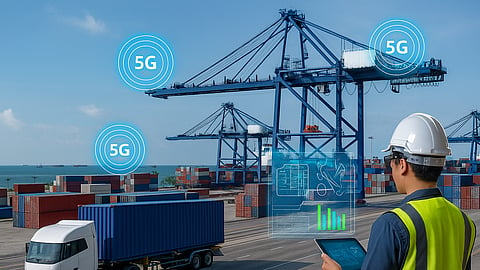5G Connectivity is Steering the Future of Middle East Ports
Across the UAE and the Middle East, ports are embracing a new era of connectivity. The rollout of 5G networks is providing the backbone for next-generation terminal operations, where data flows instantly and securely between ship, shore, and yard.
This ultra-reliable, low-latency connectivity is enabling technologies that were once experimental to become part of daily operations—redefining the region’s maritime and logistics capabilities.
Real-time remote crane operation
In traditional ports, crane operators work from high cabins, with visibility often limited by weather, vessel layout, or lighting. With 5G, high-definition video feeds from multiple angles can be transmitted without delay to operators working from comfortable control rooms onshore.
This allows precise, real-time handling of containers, improves safety, and makes crane operation possible over longer shifts without fatigue. In the UAE, this approach aligns with a strong focus on worker safety and operational excellence, positioning Gulf ports as pioneers in digital port logistics.
Autonomous truck movement within terminals
Automated Guided Vehicles (AGVs) and self-driving container trucks rely on split-second communication with control systems. 5G networks deliver the responsiveness these vehicles need to navigate busy yards, avoid obstacles, and coordinate with cranes and gates.
For Middle Eastern mega-ports, where terminal space is extensive and operations run continuously, the use of 5G-powered autonomous vehicles can optimize yard efficiency while reducing emissions and congestion.
AR-assisted maintenance and inspections
Augmented Reality is emerging as a powerful tool for port maintenance teams. Through AR glasses connected to a 5G network, technicians can view digital overlays of equipment components, receive live instructions from experts located elsewhere, and access sensor data in real time.
This means faster repairs, fewer errors, and reduced downtime for critical port machinery. In the Middle East, where ports serve as strategic trade hubs, keeping equipment in peak condition is essential for maintaining seamless trade flows.
A competitive edge for Gulf trade
The UAE and its neighbors are not simply adopting 5G—they are integrating it into a broader vision of smart, sustainable ports. By combining 5G with AI, IoT, and advanced analytics, regional ports are ensuring they can handle growing trade volumes efficiently and sustainably.
The result is a connected port ecosystem that can respond instantly to changes in demand, weather, or vessel schedules, while supporting a more sustainable maritime future.
Setting a benchmark for the global port industry
As the Middle East positions itself as a global logistics hub, the integration of 5G into port infrastructure sends a clear message: the region is not just keeping pace with technological change—it is setting the standard.
From the control room to the quay, from autonomous vehicles to AR-guided engineers, 5G is enabling smarter, safer, and more sustainable operations that will define the ports of the future.


